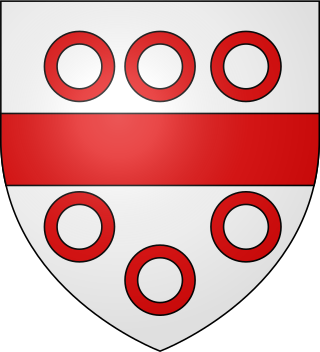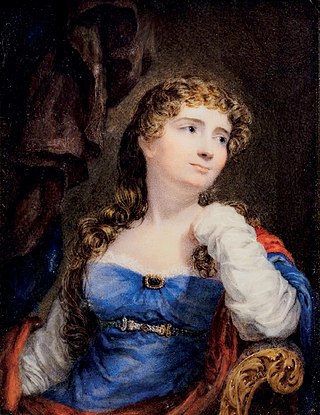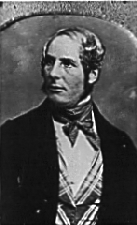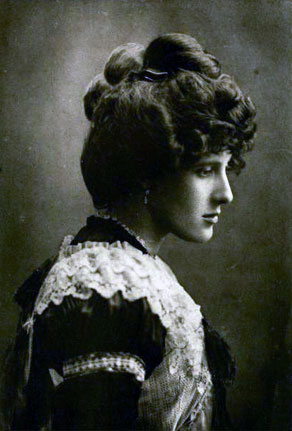
Viscount Cobham is a title in the Peerage of Great Britain that was created in 1718. Owing to its special remainder, the title has passed through several families. Since 1889, it has been held by members of the Lyttelton family.

Baron Lucas is a title that has been created twice in the Peerage of England. The second creation is extant and is currently held with the title Lord Dingwall in the Peerage of Scotland.

Baron Dacre is a title that has been created three times in the Peerage of England, each time by writ.

Baron Strange is a title which has been created four times in the Peerage of England. Two creations, one in 1295 and another in 1326, had only one holder each, upon whose deaths they became extinct. Two of the creations, that of 1299 and that of 1628, are extant. The surname Le Strange was Latinized as Extraneus. The arms of Le Strange of Knockin Castle in Shropshire were: Gules, two lions passant argent.

Earl of Norbury, in the County of Tipperary, is a title in the Peerage of Ireland. It was created in 1827, along with the title Viscount Glandine, of Glandine in the King's County, for the Irish politician and judge John Toler, 1st Baron Norbury, upon his retirement as Chief Justice of the Common Pleas in Ireland. The titles were created with special remainder to his second son, Hector, as his eldest son, Daniel, was then considered mentally unwell. Lord Norbury had already been created Baron Norbury, of Ballycrenode in the County of Tipperary, in the Peerage of Ireland in 1800, with remainder to the heirs male of his body. Moreover, his wife, Grace Toler, had been created Baroness Norwood, of Knockalton in the County of Tipperary, in the Peerage of Ireland in 1797, with remainder to the heirs male of her body. By the time Lord Norbury was raised to the Earldom, his wife had died and their eldest son had succeeded her as 2nd Baron Norwood. This son also succeeded Lord Norbury himself on his death in 1831 as 2nd Baron Norbury, whilst his younger brother Daniel succeeded to the viscountcy and earldom according to the special remainder. In 1832, the second Earl also succeeded his elder brother in the two baronies. He had already in 1825 assumed the additional surname of Graham by Royal licence.

Earl of Gainsborough is a title that has been created twice, once in the Peerage of England and once in the Peerage of the United Kingdom. The first creation ended in extinction when the sixth Earl died without heirs. However, the title was revived in 1841 for a female-line relative.

Earl of Lovelace was a title in the Peerage of the United Kingdom. It was created in 1838 for William King-Noel, 8th Baron King, a title created in 1725.

Earl of Strafford is a title that has been created three times in English and British history.

Earl of Lytton, in the County of Derby, is a title in the Peerage of the United Kingdom. It was created in 1880 for the diplomat and poet Robert Bulwer-Lytton, 2nd Baron Lytton. He was Viceroy of India from 1876 to 1880 and British Ambassador to France from 1887 to 1891. He was made Viscount Knebworth, of Knebworth in the County of Hertford, at the same time he was given the earldom, also in the Peerage of the United Kingdom.

Anne Isabella Noel Byron, 11th Baroness Wentworth and Baroness Byron, nicknamed Annabella and commonly known as Lady Byron, was an educational reformer and philanthropist who established the first industrial school in England, and was an active abolitionist. She married the poet George Gordon Byron, more commonly known as Lord Byron, and separated from him after less than a year, keeping their daughter Ada Lovelace in her custody despite laws at the time giving fathers sole custody of children.

William King-Noel, 1st Earl of Lovelace,, styled The Lord King from 1833 to 1838, was an English nobleman and scientist. He was the husband of Lord Byron's daughter Ada, today remembered as a pioneering computer scientist.
Neville Stephen Bulwer-Lytton, 3rd Earl of Lytton was a British military officer, Olympian and artist.

Lieutenant-Colonel Noel Anthony Scawen Lytton, 4th Earl of Lytton,, was a British Army officer, Arabian horse fancier and writer.

John Peter Michael Scawen Lytton, 5th Earl of Lytton,, styled Viscount Knebworth from 1951 to 1985, is a British chartered surveyor, hereditary peer and member of the House of Lords.

Judith Anne Dorothea Blunt-Lytton, 16th Baroness Wentworth, also known as Lady Wentworth, was a British peer, Arabian horse breeder and real tennis player. As the owner of the Crabbet Arabian Stud from 1917 to 1957, her influence on Arabian horse breeding was profound, with over 90 per cent of all Arabian horses in the world today carrying lines to Crabbet bloodstock in their pedigrees.
Thomas Noel, 2nd Viscount Wentworth was a British politician who succeeded to a peerage before he could take his seat in the House of Commons, having just been elected in 1774.
Byron King-Noel, 12th Baron Wentworth, styled Viscount Ockham was a British peer and the eldest of the three legitimate grandchildren of poet Lord Byron.
Ralph Gordon King-Milbanke, 2nd Earl of Lovelace was a British author of Astarte: A Fragment of Truth concerning George Gordon Byron, Sixth Lord Byron.
Milbanke is a surname, and may refer to:
Anne Lovelace, 7th Baroness Wentworth was an English peeress.















